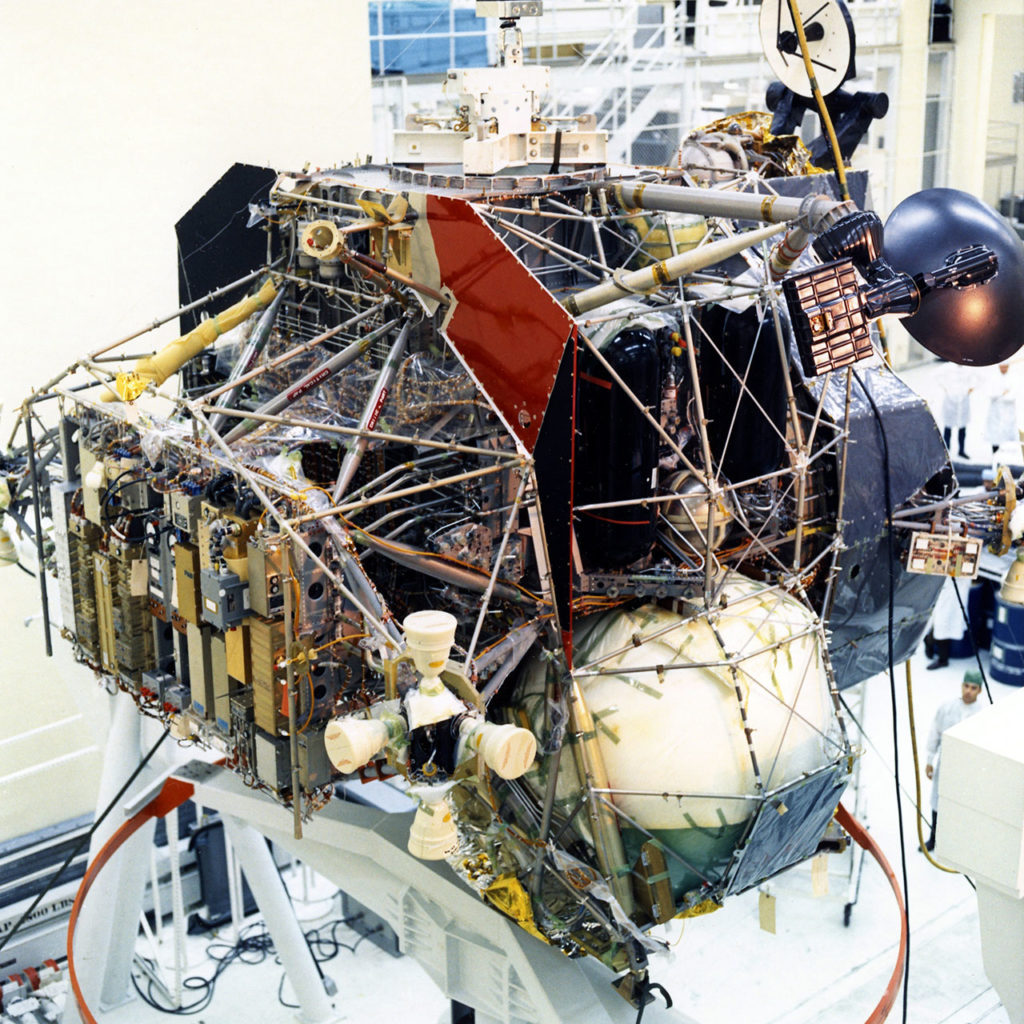
1968: Apollo 11’s LM-5 ascent stage under construction at Grumman in Bethpage, Long Island. The ascent stage without fuel weighed 2,445 kg/5,390 lb; double that with fuel. Click for a larger version.
You: “Did you say ‘guillotine’?”
Me [approximating John Cleese]: “Explosive guillotine, yes.”
August 2018 update: See also the companion article Don’t get me started, in which Apollo 17 LMP Jack Schmitt describes a mind-boggling workaround they could attempt if the ascent stage launch pyrotechnics failed to fire.
See also the comments at the end of this article for a photo of a guillotine housing, sent by a fellow who machined many of them at Grumman.
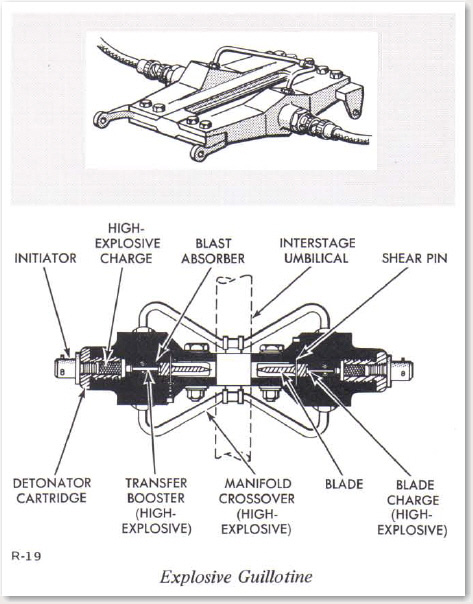
In missions past and present, explosive devices feature in pretty much every spacecraft because they’re a safe, reliable way to ensure that processes start, items such as antennas are deployed, and connected assemblies that need to come apart are quickly and cleanly separated.
On the Apollo missions, over 210 pyrotechnic devices were in the Saturn V stack and the Command, Service, and Lunar Modules, used for everything from extending the LM landing gear to deploying drogue and main parachutes to ensuring fuel was at the correct side of a tank in zero G – for which the word ullage (in French, ouillage) was borrowed from vintners, to whom it means the headspace between the top of the wine and the container it’s in, whether a cask or a bottle.
The Lunar Module had several devices on board:
Control over them was through the Explosive Devices Control Panel:
All of these devices were essential, but particularly key were the devices set off to initiate separation of the ascent and descent stages of the LM when the astronauts departed the lunar surface. This was a three-stage process that took place in the tenths of seconds before the ascent engine was lit:
- First, fire circuit interrupters to cut off electrical signals between the stages
- Second, fire and shear the four explosive nut and bolt assemblies that affix the ascent stage to the descent stage
- Third, using the explosive guillotine, slice through a thick bundle of umbilical cables and wires and a water supply line that run between the two stages
Though these devices were known to be generally reliable, a certain level of trepidation about them is understandable. Blowing up some high explosives to drive a big blade through wires doesn’t exactly sound like the most controlled process even though it actually was.
“Did you know when that unit was up on the moon, and the ascent stage was going to take off, they had all those wires – fourteen miles of them – running from the ascent stage into the descent stage, and it all had to be disconnected before you took off, or you didn’t take off? That’s all there was to it. You couldn’t use wire couplings that just pulled out when you gave it a good, hard yank. Do you want to trust a wire coupling to hold through a Saturn V liftoff and all that g-force and vibration? Uh-uh. Try flying a ship with a few loose wires. So, it was all solid connections, which is why we put a guillotine inside the descent stage: to cut all the wires. Everything had to be timed just right. The explosives had to trigger the guillotine and the blade had to cut through some pretty thick cables, and at the same time, the ascent rocket engine, which was never run before, had to start.”
– Bob Ekenstierna, LM descent stage construction supervisor at Grumman
In Chariots for Apollo by Pellegrino and Stoff, a somewhat sensationalist telling of the building of the Lunar Module at Grumman*, they speak of Joe Kingfield, the director of quality control. I won’t quote them directly since they went over the top with their narrative, but Kingfield had frequent nightmares about the liftoff from the moon that involved the guillotine and one or more of the explosive bolts failing. In his dreams, the ascent stage lifted off, but, still connected by miles of wire, dragged the descent stage along the ground and eventually crashed back into the surface. In later years, Kingfield still could not bring himself to watch the footage of the lunar liftoffs taken by the Mission Control-directed TV cameras on the Lunar Roving Vehicles of Apollo 15, 16, and 17.
*Not to be confused with the unimpeachable NASA volume of the same name by Brooks, Grimwood, and Swenson; web and epub links at the link. 2018 update: You can get a free high-quality scanned PDF of this book and many other official NASA histories – see the I got mine at the GPO bookstore post for the NASA Technical Reports Server links.
Charlie Duke, Lunar Module Pilot of the Apollo 16 Orion (the LM pictured in the Finley Quality Network banner above), said that the pyrotechnics for the ascent stage separation gave him brief pause just before he and Commander John Young lifted off from the moon. When the circuit interrupters fired, then the four interstage bolts at the corners were sheared, and finally the guillotine sliced through the umbilical and water lines, the entire ascent stage suddenly dropped an inch or so. Duke thought, “Oh, sh…” but did not have time to finish that thought as the ascent engine fired and abruptly took them away from the surface back toward Ken Mattingly awaiting their return aboard the Casper Command and Service Module in lunar orbit.
https://www.youtube.com/watch?v=yn1S-flYkaQ
You can see a fair amount of the thermal protection fly off the ascent stage as it lifts off, which happened to all of the ascent stages to some extent. In addition, panels on the rear that provided thermal protection for the Aft Equipment Bay were damaged during the liftoff, but they had done their job already. Mattingly took this photograph of the Orion before docking:
Apollo deniers like to point to this and other photographs of the Orion damage as ineluctable proof of chicanery, but what it really means is that they prefer extending and enhancing their apparently quite enjoyable fantasies to, say, reading the post-mission report (9th link in the background material):
At lunar lift-off, four vertical thermal shields (fig. 14-26) on the aft equipment rack were torn loose from the lower standoffs and remained attached only at the upper standoffs. This occurrence was observed from the lunar-based television.
The most probable cause of the failure was ascent engine exhaust entering the cavity behind these thermal shields. A cross section of the lower edge of the shields is shown in figure 14-27. Analysis shows that the thermal shield which extends below the support tube allows a pressure buildup on the closure shield which exceeds its capability. Once the closure shield failed, the exhaust entered the cavity behind the shield, resulting in a pressure buildup exceeding the capability of the vertical thermal shields.
In the lunar surface photographs taken prior to lift-off, some of the shields appear to have come loose from the center standoff (fig. 14-28). Excessive gaps between some of the panels are evident. Both conditions could be caused by excessive pressure in the thermal blanket due to insufficient venting during boost.
The corrective action will include a redesign of the thermal shield to eliminate the projection below the support tube, as shown in figure 14-27, and to provide additional venting to the blankets as well as additional standoffs.
This anomaly is closed.
Not one problem was detected in any of the pyrotechnics during any Apollo mission. The device designs used in Apollo were later adopted by the Shuttle program, with, for instance, the Single-Bridgewire Apollo Standard Initiator (SBASI) becoming the NASA Standard Initiator (NSI).

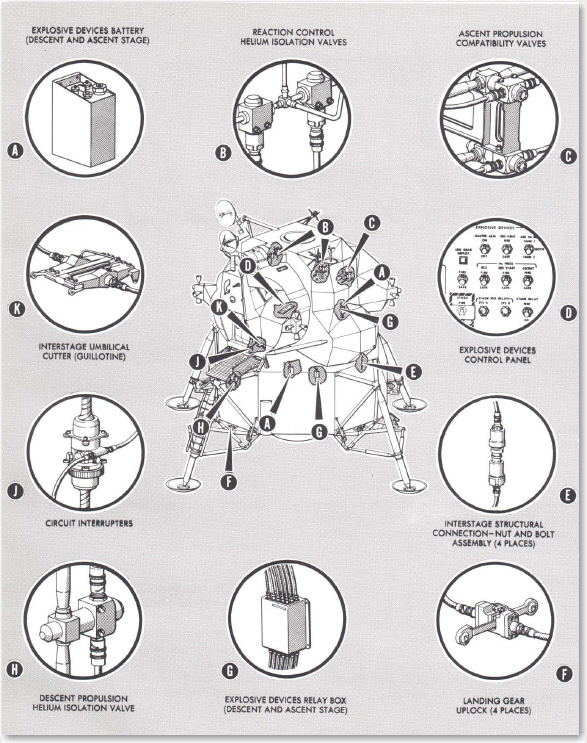
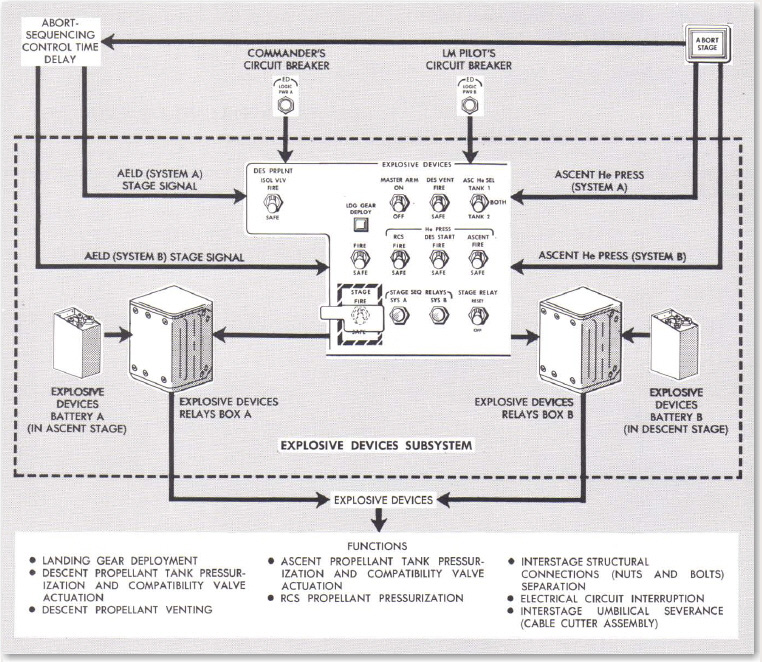
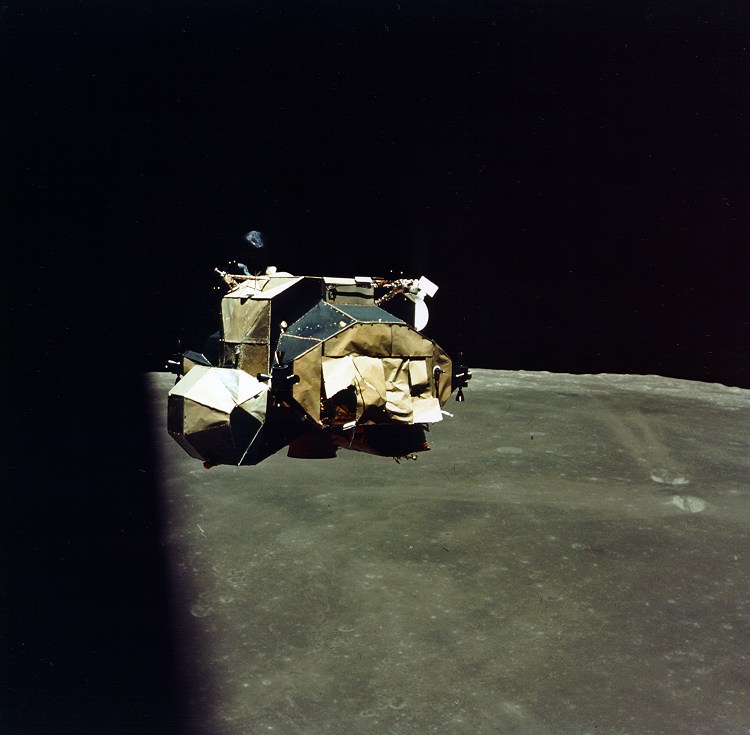

Tom wrote to ask:
I enjoyed your post about the explosive guillotines in the Lunar Module. It made me wonder about the interface between the descent and ascent stage. Did the ascent engine fire directly into the descent stage? Or was there a hole for the ascent engine to vent through?
Tom
Yes, the ascent engine did fire directly into the descent stage. Above the descent engine was essentially an empty box. You can see in the Grumman photo below of the Apollo 13 descent stage that there was some thermal shielding above the descent engine, but that was in-flight shielding only and not meant to protect during lunar liftoff – no need since the descent stage’s work was done. The dip in that shielding, which looks to me to be at least 18″ deep, was to accommodate the ascent engine bell.
There was a good amount of exhaust blowback during lunar liftoff, hence the dozens of bits of shielding you see flying off the descent stage in the Apollo 15, 16, and 17 lunar liftoff videos – most of which was from right under the ascent engine – and the damage sustained on the rear of Orion‘s ascent stage during Apollo 16.
The interstage connection where the guillotine was located is circled in this photo of the Apollo 9 Spider ascent stage:
Thanks for the answer lalmon! I suppose, if anything, an initially restricted exhaust space, would increase the ascent thrust a tiny bit.
That “empty box” gap you speak of must’ve been sturdy. Certainly stronger than the engine bell of the decent stage that was designed to buckle and actually did on Apollo 15.
Watching the amazing series Moon Machines (available on Youtube), you really have to feel for the lunar module designers. In particular they were sick with fear the ascend engine might have a problem, with little the astronauts could do about it. Due to the highly corrosive hypergolic fuel used in both LM engines, they couldn’t test fire the actual engines used before hand. They were fired for the first time on the Moon! Hear the engineers talking here.
Can you imagine if everything worked perfectly except the guillotine… I bet the engineers who created it couldn’t prevent that hideous mental image!
Yes. The center of the descent stage is hollow in order for the hot ascent motor gases to vent, except of course the descent engine which occupied in the center of that hollow. The gases swept right around this now useless engine.
I was the designer of the attachment system for the Guillotine and its related systems. It was attached to the bottom of the Ascent Stage lower shielding structure. Some NASA drawings are incorrect showing it on th forward end. The designer of the Guillotine was Gene Tiefenworth. He and I worked together to make sure the system met the structural, thermal and micrometeoroide protection necessary for a safe space flight. Many of us watched with baited breath the first Lunar departure and were very much elated when everything worked as expected. I was just 27 years old at the time, but never had such a great event happened in my aerospace career that spanned 43 years in total.
Thanks for that information, Carlos. I must say that in my hundreds of thousands of pages of Apollo study, I’ve never seen a drawing or photo showing exactly where it was. It looks like one of my comments is wrong – from my reading, I did think it was at the forward end as pictured above.
I can imagine how thrilling it was to see it work flawlessly – and six times at that. My hat’s off to you. I think we haven’t ever done anything even one quarter as exciting as Apollo. It was like living in the future when I was a kid – I was two weeks shy of ten years old on 20 July 1969.
Salmon,
thank you for your kind words. Back in 1995 I showed a colleague my notebook (a pre-requisite on all good designers), when I was working for McDonnell Douglas in St. Louis (I left Grumman Bethpage, NY in 1994). That unfortunately is the last time I saw my notebook. I kept detail sketches of this complex installation. You cannot imagine the loss I feel of having misplaced this most valuable notebook. I have all other notebooks (F-14A. SPACE SHUTTLE PROPOSAL, EF111A, E-2C, C-2A, AFX, etc. None are as valuable as my first notebook. The support on the Ascent Stage was mounted to the Heat shield. We used fiberglass components to minimize heat transfer but had aluminum fittings to make the structural connection, The thermal blankets had many layers and had to be vented (during the trip to space). They were attached with nylon standoff molded like little I beams that’d a special helicoil to accept a screw to hold the external (.004 to as big as .012 inch) shield. Everything was super light and fragile. The blankets were held together by what we called a “drug store wrap”. We had nothing to go by, so we invented everything ourselves. I just finished writing a short story that I called “going to the Moon”. It is mostly about the people who made it happen and is kind of humorous, because engineers can be funny and I lived with many of them
What was in your notebooks? I worked at McDonnel Douglas in St. Louis in the 80’s as a designer. I did not know anyone who had a notebook. Sounds like a good idea. We had The Design Handbook and The Standard Parts Manual. I once had to look up the structures analysis handbook on one part from more than 10 years prior to find out why, with all the other formers being made out of sheet metal, there was one that was machined. It was the only page that did not start with the Free Body Diagram in the upper right corner of the page. And sure enough, one of the first equations had the direction of a force in the wrong direction. At Georgia Tech, we were taught to always put up that diagram. It was worth like 2 problems’ worth of points on a test. But I did not see any design notebooks. As to the former. In the end, we left it. The new, better, engines made the aircraft a little tail heavy anyway, and it was not worth it to change the other parts to save a couple of ounces. I mean, a couple of hundred grams.
I still have this Guillotine Housing. I machined many of these back in the mid 60’s. The Guillotine Housing in the picture was not in tolerance, so I was able to keep it as a souvenir. Now we can Google and find a recent photo of a 50 year old “Lunar Module Interstage Umbilical Guillotine”
Tim
That’s pretty cool. Say, what are the dimensions of the housing? It’s never been clear to me from any drawing, but my guess has been something like 8″ wide.
The Guillotine Housing Is 7.12 X 2.95 X 1.75
Tim
[…] The excerpt below is from the site of Apollo 17 Lunar Module Pilot and geologist Harrison Schmitt, and it’s the most…well, invigorating description of a jump start I’ve ever read. This goes hand-in-hand with my article on The explosive guillotine in the Lunar Module. […]
Before the the guillotine was activated the battery power between the descent and ascent stages had to be disconnected along with other circuits. This was done done via two Deadface connectors which were also actived via pyro devices. The separation sequence was quite complex.
I’ve read a lot about Apollo but never knew about this explosive guillotine. I wonder if the 3 remaining LM’s(Canx Apollo’s 18, 19, 20) here on earth still have these guillotine housings or did they strip them before putting them in museums on the east coast? The LM is the most remarkable piece of machinery I’ve ever seen.
I imagine the housings might still be in place in some of the extant LMs, but not the explosives. The explosive charges themselves were installed late in the process, when spacecraft were being prepared for launch. Fitting of the explosives was not done in the Manned Spacecraft Operations Building at KSC, but wisely in the completely separate Pyrotechnics Installation Building.
Hey Tim,
Do the cartridges at the back of the SpaceX Dragon trunk look like the guillotine housings you made? Picture (with cartridges encircled) below. Thanks!